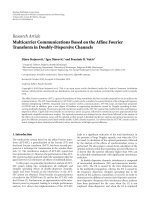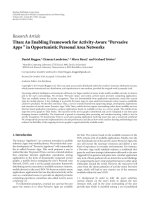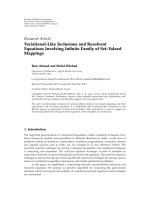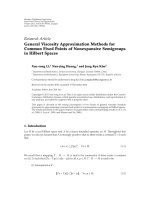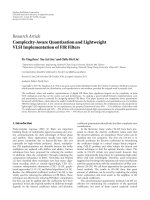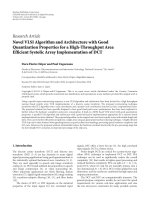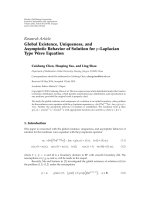Báo cáo hóa học: " Research Article Coupled Coincidence Point and Coupled Common Fixed Point Theorems in Partially Ordered Metric Spaces with w-Distance" pptx
Bạn đang xem bản rút gọn của tài liệu. Xem và tải ngay bản đầy đủ của tài liệu tại đây (489.97 KB, 11 trang )
Hindawi Publishing Corporation
Fixed Point Theory and Applications
Volume 2010, Article ID 134897, 11 pages
doi:10.1155/2010/134897
Research Article
Coupled Coincidence Point and Coupled Common
Fixed Point Theorems in Partially Ordered Metric
Spaces with w-Distance
Mujahid Abbas,
1
Dejan Ili
´
c,
2
and Muhammad Ali Khan
1
1
Department of Mathematics, Lahore University of Management Sciences, 54792 Lahore, Pakistan
2
Department of Mathematics, Faculty of Sciences and Mathematics, University of Ni
ˆ
s, Vi
ˆ
segradska 33,
18000 Ni
ˆ
s, Serbia
Correspondence should be addressed to Dejan Ili
´
c,
Received 7 April 2010; Accepted 18 October 2010
Academic Editor: Hichem Ben-El-Mechaiekh
Copyright q 2010 Mujahid Abbas et al. This is an open access article distributed under the
Creative Commons Attribution License, which permits unrestricted use, distribution, and
reproduction in any medium, provided the original work is properly cited.
We introduce the concept of a w-compatible mapping to obtain a coupled coincidence point and a
coupled point of coincidence for nonlinear contractive mappings in partially ordered metric spaces
equipped with w-distances. Related coupled common fixed point theorems for such mappings are
also proved. Our results generalize, extend, and unify several well-known comparable results in
the literature.
1. Introduction and Preliminaries
In 1996, Kada et al. 1 introduced the notion of w-distance. They elaborated, with the help
of examples, that the concept of w-distance is general than that of metric on a nonempty set.
They also proved a generalization of Caristi fixed point theorem employing the definition of
w-distance on a complete metric space. Recently, Ili
´
c and Rako
ˇ
cevi
´
c 2 obtained fixed point
and common fixed point theorems in terms of w-distance on complete metric spaces see also
3–9.
Definition 1.1. Let X, d be a metric space. A mapping p : X × X → 0, ∞ is called a w-
distance on X if the following are satisfied:
w
1
px, z ≤ px, ypy,z for all x, y, z ∈ X,
w
2
for any x ∈ X,px, · : X → 0, ∞ is lower semicontinuous,
2 Fixed Point Theory and Applications
w
3
for any ε>0 there exists δε > 0 such that pz, x ≤ δ and pz, y ≤ δ imply
px, y ≤ ε, for any x, y, z ∈ X.
The metric d is a w-distance on X. For more examples of w-distances, we refer to 10.
Definition 1.2. Let X be a nonempty set with a w-distance on X. Ones denotes the w-closure
of a subset B of X by cl
ω
B which is defined as
cl
ω
B
x ∈ X : p
x
n
,x
−→ 0 for some sequence
{
x
n
}
in B
∪ B. 1.1
The next Lemma is crucial in the proof of our results.
Lemma 1.3 see 1. Let X, d be a metric space, and let p be a w-distance on X.Let{x
n
} and
{y
n
} be sequences in X,letα
n
and β
n
be sequences in 0, ∞ converging to 0, and let x, y, z ∈ X.
Then the following hold.
1 If px
n
,y ≤ α
n
and px
n
,z ≤ β
n
for any n ∈ N,theny z. In particular, if px, y
0, px, z0 then y z.
2 If px
n
,y
n
≤ α
n
and px
n
,z ≤ β
n
for any n ∈ N,theny
n
converges to z.
3 If px
n
,x
m
≤ α
n
for any m, n ∈ N with n ≺ m,thenx
n
is a Cauchy sequence.
4 If py, x
n
≤ α
n
for any n ∈ N,thenx
n
is a Cauchy sequence.
Bhaskar and Lakshmikantham in 11 introduced the concept of coupled fixed point
of a mapping F : X ×X → X and investigated some coupled fixed point theorems in partially
ordered sets. They also discussed an application of their result by investigating the existence
and uniqueness of solution for a periodic boundary value problem. Sabetghadam et al. in 12
introduced this concept in cone metric spaces. They investigated some coupled fixed point
theorems in cone metric spaces. Recently, Lakshmikantham and
´
Ciri
´
c 13 proved coupled
coincidence and coupled common fixed point theorems for nonlinear contractive mappings
in partially ordered complete metric spaces which extend the coupled fixed point theorem
given in 11. The following are some other definitions needed in the sequel.
Definition 1.4 see 12.LetX be any nonempty set. Let F : X × X → X and g : X → X be
two mappings. An ordered pair x, y ∈ X × X is called
1 a coupled fixed point of a mapping F : X × X → X if x Fx, y and y Fy, x,
2 a coupled coincidence point of hybrid pair {F, g} if
gxFx, y and gy
Fy, x and gx,gy is called coupled point of coincidence,
3 a common coupled fixed point of hybrid pair {F, g} if x gxFx, y and
y gyFy, x.
Note that if x, y is a coupled fixed point of F, then y, x is also a coupled fixed point of the
mapping F.
Definition 1.5. Let X be any nonempty set. Mappings F : X × X → X and g : X → X are
called w-compatible if gFx, y Fgx,gy whenever gx
Fx, y and gyFy, x.
Fixed Point Theory and Applications 3
Definition 1.6. Let X, d be a metric space with w-distance p. A mapping F : X × X → X
is said to be w-continuous at a point x, y ∈ X × X with respect to mapping g : X → X
if for every ε>0 there exists a δε > 0 such that pgu, gxpgv,gy <δimplies that
pFx, y,Fu, v <εfor all u, v ∈ X.
Definition 1.7. Let X be a partially ordered set. Mapping g : X → X is called strictly
monotone increasing mapping if
x y ⇐⇒ gx gy or equivalentlyx y ⇐⇒ gx gy. 1.2
Definition 1.8. Let X
be a partially ordered set. A mapping F : X × X → X is said to be a
mixed monotone if Fx, y is monotone nondecreasing in x and monotone nonincreasing in
y, that is, for any x, y ∈ X,
x
1
,x
2
∈ X, x
1
x
2
⇒ F
x
1
,y
F
x
2
,y
,
y
1
,y
2
∈ X, y
1
y
2
⇒ F
x, y
1
F
x, y
2
.
1.3
Kada et al. 1 gave an example to show that p is not symmetric in general. We denote by
MX and M
1
X, respectively, the class of all w-distances on X and the class of all w-
distances on X which are symmetric for comparable elements in X. Also in the sequel, we
will consider that x, y and u, v are comparable with respect to ordering in X × X if x u
and y v.
2. Coupled Coincidence Point
In this section, we prove coincidence point results in the frame work of partially ordered
metric spaces in terms of a w-distance.
Theorem 2.1. Let X, d be a partially ordered metric space with a w-distance p and g : X → X a
strictly monotone increasing mapping. Suppose that a mixed monotone mapping F : X × X → X is
w-continuous with respect to g such that
p
F
x, y
,F
u, v
≤ a
1
p
gu, gx
a
2
p
gv,gy
, 2.1
for all x, y, u, v ∈ X with x u, y v or x u, y v and a
1
a
2
< 1.LetFX × X ⊆ gX and
py, x0 whenever px, y0,forsomex, y ∈ cl
ω
FX × X.IfgX is complete and there exist
x
0
,y
0
∈ X such that gx
0
Fx
0
,y
0
and Fy
0
,x
0
gy
0
,thenF and g have a coupled coincidence
point.
Proof. Let gx
1
Fx
0
,y
0
and gy
1
Fy
0
,x
0
for some x
1
,y
1
∈ X; this can be done since
FX × X ⊆ gX. Following the same arguments, we obtain gx
2
Fx
1
,y
1
and gy
2
Fy
1
,x
1
.Put
F
1
x
0
,y
0
gx
1
,F
2
x
0
,y
0
F
x
1
,y
1
gx
2
,
F
2
y
0
,x
0
F
y
1
,x
1
gy
2
.
2.2
4 Fixed Point Theory and Applications
Similarly for all n ∈ N,
gx
n1
F
n1
x
0
,y
0
,gy
n1
F
n1
y
0
,x
0
.
2.3
Since g is strictly monotone increasing and F has the mixed monotone property, we have
gx
2
F
2
x
0
,y
0
F
x
1
,y
1
F
x
0
,y
0
gx
1
,gy
2
gy
1
.
2.4
Similarly
gx
0
F
x
0
,y
0
gx
1
F
2
x
0
,y
0
gx
2
···
F
n1
x
0
,y
0
gx
n1
··· ,
gy
0
F
y
0
,x
0
gy
1
F
2
y
0
,x
0
gy
2
···
F
n1
y
0
,x
0
··· .
2.5
Now for all n ≥ 2, using 2.1,weget
p
F
n
x
0
,y
0
,F
n1
x
0
,y
0
p
F
x
n−1
,y
n−1
,F
x
n
,y
n
≤ a
1
p
gx
n
,gx
n−1
a
2
p
gy
n
,gy
n−1
a
1
p
F
n
x
0
,y
0
,F
n−1
x
0
,y
0
a
2
p
F
n
y
0
,x
0
,F
n−1
y
0
,x
0
,
p
F
n
y
0
,x
0
,F
n1
y
0
,x
0
≤ a
1
p
F
n
y
0
,x
0
,F
n−1
y
0
,x
0
a
2
p
F
n
x
0
,y
0
,F
n−1
x
0
,y
0
.
2.6
From 2.6,
p
F
n
x
0
,y
0
,F
n1
x
0
,y
0
p
F
n
y
0
,x
0
,F
n1
y
0
,x
0
≤ h
p
F
n
x
0
,y
0
,F
n−1
x
0
,y
0
p
F
n
y
0
,x
0
,F
n−1
y
0
,x
0
,
2.7
where h a
1
a
2
. Continuing, we conclude that
p
F
n
x
0
,y
0
,F
n1
x
0
,y
0
p
F
n
y
0
,x
0
,F
n1
y
0
,x
0
≤ h
n
p
gx
1
,gx
0
p
gy
1
,gy
0
h
n
δ
1
2.8
Fixed Point Theory and Applications 5
if n is odd, where δ
1
pgx
1
,gx
0
pgy
1
,gy
0
.Also,
p
F
n
x
0
,y
0
,F
n1
x
0
,y
0
p
F
n
y
0
,x
0
,F
n1
y
0
,x
0
≤ h
n
p
gx
0
,gx
1
p
gy
0
,gy
1
h
n
δ
2
2.9
if n is even, where
δ
2
p
gx
0
,gx
1
p
gy
0
,gy
1
. 2.10
Let δ
n
pF
n
x
0
,y
0
,F
n1
x
0
,y
0
pF
n
y
0
,x
0
,F
n1
y
0
,x
0
; then for every n in N we have
δ
n
≤ h
n
δ
0
, 2.11
where
δ
0
max
{
δ
1
,δ
2
}
. 2.12
Hence,
p
F
n
x
0
,y
0
,F
n1
x
0
,y
0
−→ 0,p
F
n
y
0
,x
0
,F
n1
y
0
,x
0
−→ 0asn −→ ∞ . 2.13
For m>n,weget
p
F
n
x
0
,y
0
,F
m
x
0
,y
0
p
F
n
y
0
,x
0
,F
m
y
0
,x
0
≤ p
F
n
x
0
,y
0
,F
n1
x
0
,y
0
p
F
n1
x
0
,y
0
,F
n2
x
0
,y
0
···
p
F
m−1
x
0
,y
0
,F
m
x
0
,y
0
p
F
n
y
0
,x
0
,F
n1
y
0
,x
0
p
F
n1
y
0
,x
0
,F
n2
y
0
,x
0
···
p
F
m−1
y
0
,x
0
,F
m
y
0
,x
0
δ
n
δ
n1
··· δ
m−1
≤ h
n
δ
0
h
n1
δ
0
··· h
m−1
δ
0
≤
h
n
1 − h
δ
0
2.14
which further implies that
p
F
n
x
0
,y
0
,F
m
x
0
,y
0
≤
h
n
1 − h
δ
0
p
F
n
y
0
,x
0
,F
m
y
0
,x
0
≤
h
n
1 − h
δ
0
.
2.15
6 Fixed Point Theory and Applications
Lemma 1.33 implies that {F
n
x
0
,y
0
} {gx
n
} and {F
n
y
0
,x
0
} {gy
n
} are Cauchy
sequences in gX. Since gX is complete, there exist x, y ∈ X such that gx
n
→ gx and
gy
n
→ gy. Since pgx
n
, · is lower semicontinuous, we have
p
F
n
x
0
,y
0
,gx
≤ lim inf
m →∞
p
gx
n
,gx
m
≤
h
n
1 − h
δ
0
2.16
which implies that
p
F
n
x
0
,y
0
,gx
−→ 0asn −→ ∞ . 2.17
Similarly
p
F
n
y
0
,x
0
,gy
−→ 0asn −→ ∞ . 2.18
Let ε>0 be given. Since F is w-continuous at x, y with respect to g, there exists δ>0 such
that for each n
p
gx
n
,gx
p
gy
n
,gy
<δimplies that p
F
x, y
,F
x
n
,y
n
<
ε
2
.
2.19
Since pgx
n
,gx → 0andpgy
n
,gy → 0, for γ minε/2,δ/2, there exists n
0
such that,
for all n ≥ n
0
,
p
gx
n
,gx
<γ, p
gy
n
,gy
<γ. 2.20
Now,
p
F
x, y
,gx
≤ p
F
x, y
,F
n
0
1
x
0
,y
0
p
F
n
0
1
x
0
,y
0
,gx
p
F
x, y
,F
x
n
0
,y
n
0
p
gx
n
0
1
,gx
<
ε
2
γ ε
2.21
implies that pFx, y,gx0. Since
p
F
n
x
0
,y
0
,F
x, y
≤ p
F
n
x
0
,y
0
,gx
p
gx,F
x, y
≤
h
n
1 − h
δ
0
,
2.22
using Lemma 1.31,weobtainFx, ygx. Similarly, we can prove that Fy, xgy. Hence
x, y is coupled coincidence point of F and g.
Fixed Point Theory and Applications 7
Theorem 2.2. Let X, d be a partially ordered metric space with a w-distance p having the following
properties.
1 If {x
n
} is in X with x
n
x
n1
for all n and x
n
→ x for some x ∈ X,thenx
n
x for all
n.
2 If {y
n
} is in X with y
n1
y
n
for all n and y
n
→ y for some y ∈ X,theny y
n
for all
n.
Let F : X × X → X be a mixed monotone and g : X → X a strict monotone increasing
mapping such that
p
F
x, y
,F
u, v
≤ a
1
p
gu, gx
a
2
p
gv,gy
, 2.23
for all x, y, u, v ∈ X with x u, y v or x u, y v and a
1
a
2
< 1. Let FX × X ⊆ gX
and py, x0 whenever px, y0, for some x, y ∈ cl
ω
FX × X.IfgX is complete and
there exist x
0
,y
0
∈ X such that gx
0
Fx
0
,y
0
and Fy
0
,x
0
gy
0
, then F and g have a
coupled coincidence point.
Proof. Construct two sequences {gx
n
} {F
n
x
0
,y
0
} and {gy
n
} {F
n
y
0
,x
0
} such that
gx
n
gx
n1
and gy
n
gy
n1
for all n and gx
n
→ gx and gy
n
→ gy for some x ∈ X,as
given in the proof of Theorem 2.1. Now, we need to show that Fx, ygx and Fy, xgy.
Let ε>0. Since pF
n
x
0
,y
0
,gx → 0andpF
n
y
0
,x
0
,gy → 0, there exists n
1
∈ N such
that, for all n ≥ n
1
, we have
p
F
n
x
0
,y
0
,gx
<
ε
3
,p
F
n
y
0
,x
0
,gy
<
ε
3
. 2.24
Consider
p
F
x, y
,gx
≤ p
F
x, y
,F
n1
x
0
,y
0
p
F
n1
x
0
,y
0
,gx
p
F
x, y
,F
x
n
,y
n
p
F
n1
x
0
,y
0
,gx
≤ a
1
p
gx
n
,gx
a
2
p
gy
n
,gy
p
F
n1
x
0
,y
0
,gx
a
1
p
F
n
x
0
,y
0
,gx
a
2
p
F
n
y
0
,x
0
,gy
p
F
n1
x
0
,y
0
,gx
<a
1
ε
3
a
2
ε
3
ε
3
<ε,
2.25
which implies that pFx, y,gx0. Also, from Theorem 2.1, we have
p
F
n
x
0
,y
0
,gx
≤
h
n
1 − h
δ
0
.
2.26
8 Fixed Point Theory and Applications
Therefore,
p
F
n
x
0
,y
0
,F
x, y
≤ p
F
n
x
0
,y
0
,gx
p
gx,F
x, y
≤
h
n
1 − h
δ
0
2.27
implies that gx Fx, y. Similarly, we can prove that Fy, xgy. Hence x, y is coupled
coincidence point of F and g.
3. Coupled Common Fixed Point
In this section, using the concept of w-compatible maps, we obtain a unique coupled common
fixed point of two mappings.
Theorem 3.1. Let all the hypotheses of Theorem 2.1 (resp., Theorem 2.2) hold with a
1
a
2
< 1/2.If
for every x, y, x
∗
,y
∗
∈ X × X there exists u, v ∈ X × X that is comparable to x, y and x
∗
,y
∗
with respect to ordering in X × X, then there exists a unique coupled point of coincidence of F and g.
Moreover if F and g are w-compatible, then F and g have a unique coupled common fixed point.
Proof. Let gx
∗
,gy
∗
be another coupled coincidence point of F and g. We will discuss the
following two cases.
Case 1. If x, y is comparable to x
∗
,y
∗
with respect to ordering in X × X, then
p
gx,gx
∗
p
gy,gy
∗
p
F
x, y
,F
x
∗
,y
∗
p
F
y, x
,F
y
∗
,x
∗
≤ a
1
p
gx
∗
,gx
a
2
p
gy
∗
,gy
a
1
p
gy
∗
,gy
a
2
p
gx
∗
,gx
≤
a
1
a
2
p
gx,gx
∗
p
gy,gy
∗
3.1
implies that pgx,gx
∗
pgy,gy
∗
0. Hence pgx,gx
∗
0 pgy,gy
∗
.Also,
p
gx,gx
p
gy,gy
p
F
x, x
,F
x, x
p
F
y, y
,F
y, y
≤ 2a
1
p
gx,gx
2a
2
p
gy,gy
3.2
gives that pgx,gx0 pgy,gy. The result follows using Lemma 1.31.
Case 2. If x, y is not comparable to x
∗
,y
∗
, then there exists an upper bound or lower
bound u, v of x, y, x
∗
,y
∗
. Again since g is strictly monotone increasing mapping and
F satisfies mixed monotone property, therefore, for all n 0, 1, ,F
n
u, v,F
n
v, u is
Fixed Point Theory and Applications 9
comparable to F
n
x, y,F
n
y, x gx,gy and F
n
y, x,F
n
x, y gy,gx. Following
similar arguments to those given i n the proof of Theorem 2.1,weobtain
p
gx,gx
∗
p
gy,gy
∗
p
F
n
x, y
,F
n
x
∗
,y
∗
p
F
n
y, x
,F
n
y
∗
,x
∗
≤
p
F
n
x, y
,F
n
u, v
p
F
n
u, v
,F
n
x
∗
,y
∗
p
F
n
y, x
,F
n
v, u
p
F
n
v, u
,F
n
y
∗
,x
∗
p
F
n
x, y
,F
n
u, v
p
F
n
y, x
,F
n
v, u
p
F
n
u, v
,F
n
x
∗
,y
∗
p
F
n
v, u
,F
n
y
∗
,x
∗
≤ h
n
β
0
h
n
γ
0
,
3.3
where β
0
max{pgu, gxpgv,gy,pgx,gupgy,gv} and γ
0
max{pgx
∗
,gu
pgy
∗
,gv,pgu,gx
∗
pgv,gy
∗
}. On taking limit as n →∞on both sides of 3.3,we
have
p
gx,gx
∗
p
gy,gy
∗
0 3.4
and pgx,gx
∗
0 pgy,gy
∗
. By the same lines as in Case 1, we prove that pgx,gx
0 pgy,gy. Again Lemma 1.31 implies that gx gx
∗
and gy gy
∗
. Hence gx,gy is
unique coupled point of coincidence of F and g.Notethatifgx,gy is a coupled point of
coincidence of F and g, then gy,gx are also a coupled points of coincidence of F and g.
Then gx gy and therefore gx,gx is unique coupled point of coincidence of F and g.Let
u gx. Since F and g are w-compatible, we obtain
gu g
gx
g
F
x, x
F
gx,gx
F
u, u
. 3.5
Consequently gu gx. Therefore u gu Fu, u. Hence u, u is a coupled common fixed
point of F and g
.
Remark 3.2. If in addition to the hypothesis of Theorem 2.1 resp., Theorem 2.2 we suppose
that p ∈ M
1
X, x
0
and y
0
are comparable, then gx gy.
Proof. Recall that gx
0
Fx
0
,y
0
.Now,ifx
0
y
0
, then gx
0
gy
0
. We claim that, for all
n ∈ N, gx
n
gy
n
. Since g is strictly monotone increasing and F satisfies mixed monotone
property, we have
gx
1
F
x
0
,y
0
F
y
0
,x
0
gy
1
. 3.6
Assuming that gx
n
gy
n
,sinceg is strictly monotone increasing, so x
n
y
n
. By the mixed
monotone property of F, we have
gx
n1
F
n1
x
0
,y
0
F
x
n
,y
n
F
y
n
,x
n
gy
n1
.
3.7
10 Fixed Point Theory and Applications
Therefore,
gx
n
gy
n
∀n. 3.8
Letting ε>0, there exists an n
0
∈ N such that pgx,F
n
x
0
,y
0
<ε/4andpF
n
y
0
,x
0
,gy <
ε/4 for all n ≥ n
0
.Now,
p
gx,gy
≤ p
gx,F
n
0
1
x
0
,y
0
F
n
0
1
x
0
,y
0
,gy
≤ p
gx,F
n
0
1
x
0
,y
0
p
F
n
0
1
x
0
,y
0
,F
n
0
1
y
0
,x
0
F
n
0
1
y
0
,x
0
,gy
<
ε
4
hp
F
n
0
x
0
,y
0
,F
n
0
y
0
,x
0
ε
4
≤
ε
2
h
p
F
n
0
x
0
,y
0
,gx
p
gx,gy
gy,F
n
0
y
0
,x
0
<
ε
2
h
ε
4
hp
gx,gy
h
ε
4
<ε hp
gx,gy
3.9
implies that 1 − hpgx,gy <ε. Since h<1, therefore pgx,gy0. Similarly we can prove
that pgx,gx0. Hence by Lemma 1.31, we have gx gy. Similarly, if gx
0
gy
0
, we can
show that gx
n
gy
n
for each n and gx gy.
Acknowledgment
The present version of the paper owes much to the precise and kind remarks of the learned
referees.
References
1 O. Kada, T. Suzuki, and W. Takahashi, “Nonconvex minimization theorems and fixed point theorems
in complete metric spaces,” Mathematica Japonica, vol. 44, no. 2, pp. 381–391, 1996.
2 D. Ili
´
candV.Rako
ˇ
cevi
´
c, “Common fixed points for maps on metric space with w-distance,” Applied
Mathematics and Computation, vol. 199, no. 2, pp. 599–610, 2008.
3 L. Guran, “Fixed points for multivalued operators with respect to a w-distance on metric spaces,”
Carpathian Journal of Mathematics, vol. 23, no. 1-2, pp. 89–92, 2007.
4 L J. Lin and W S. Du, “Some equivalent formulations of the generalized Ekeland’s variational
principle and their applications,” Nonlinear Analysis: Theory, Methods & Applications, vol. 67, no. 1,
pp. 187–199, 2007.
5 L J. Lin and W S. Du, “Systems of equilibrium problems with applications to new variants of
Ekeland’s variational principle, fixed point theorems and parametric optimization problems,” Journal
of Global Optimization, vol. 40, no. 4, pp. 663–677, 2008.
6 J. R. Morales, “Generalizations of Some Fixed Point Theorems,” Notas de mathematica, 1999. Pre-Print,
no. 199.
7 J. R. Morales, “Fixed point’s theorems for ω-ϕ-contractions,” Notas de mathematica, 2004. Pre-Print, no.
230.
Fixed Point Theory and Applications 11
8 Q. H. Ansari, “Vectorial form of Ekeland-type variational principle with applications to vector
equilibrium problems and fixed point theory,” Journal of Mathematical Analysis and Applications, vol.
334, no. 1, pp. 561–575, 2007.
9 J S. Ume, “Fixed point theorems related to
´
Ciri
´
c’s contraction principle,” Journal of Mathematical
Analysis and Applications, vol. 225, no. 2, pp. 630–640, 1998.
10 W. Takahashi, Nonlinear Functional Analysis: Fixed Point Theory and Its Applications, Yokohama
Publishers, Yokohama, Japan, 2000.
11 T. G. Bhaskar and V. Lakshmikantham, “Fixed point theorems in partially ordered metric spaces and
applications,” Nonlinear Analysis: Theory, Methods and Applications, vol. 65, no. 7, pp. 1379–1393, 2006.
12 F. Sabetghadam, H. P. Masiha, and A. H. Sanatpour, “Some coupled fixed point theorems in cone
metric spaces,” Fixed Point Theory and Applications, vol. 2009, Article ID 125426, 8 pages, 2009.
13 V. Lakshmikantham and L.
´
Ciri
´
c, “Coupled fixed point theorems for nonlinear contractions in
partially ordered metric spaces,” Nonlinear Analysis: Theory, Methods & Applications, vol. 70, no. 12,
pp. 4341–4349, 2009.



